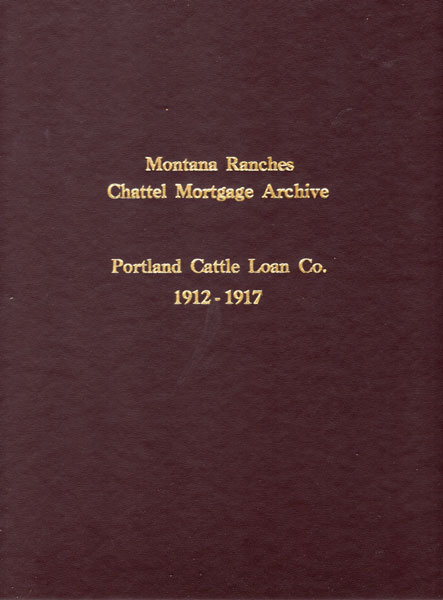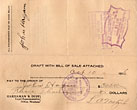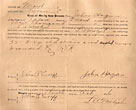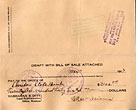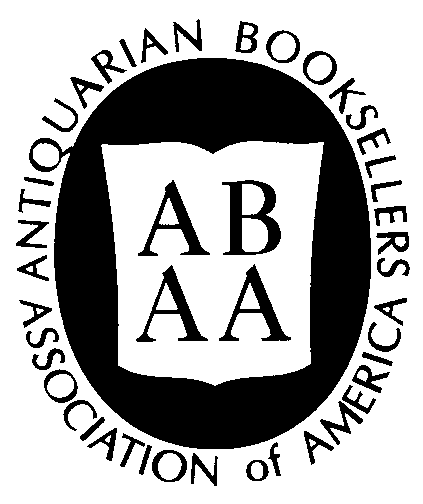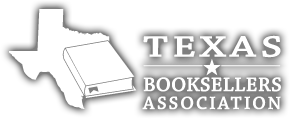Dealer in Rare and First-Edition Books: Western Americana; Mystery, Detective, and Espionage Fiction
A Remarkable Archive Of Chattel Mortgage Documents, Loan Documents, And Receipts Between The Portland Cattle Loan Company And Montana Ranchers 1912-1917
WALTER P. (PRESIDENT) AND CHARLES H. CAREY (DIRECTOR) DICKEY
Other works by WALTER P. (PRESIDENT) AND CHARLES H. CAREY (DIRECTOR) DICKEYPublication: Portland Cattle Loan Company, 1912-1917, North Portland, Oregon
First edition. Quarto. Housed in a recent brown colored three-ring binder with titles stamped in gold gilt on the front cover. The archive consists of 159 leaves in 55 transparent archival polyester sleeves, most with original manuscript signatures, manuscript cattle and stock brand illustrations, documentation, many with typed notes, many with Montana state notary seals, nearly all printed on light khaki-colored paper stock. A remarkable archive of Chattel Mortgage documents, loan documents, and receipts between Portland Cattle Loan Company and Montana ranchers in the preceding years to WWI. These Chattel Mortgages detail the tremendous growth of financing for ranches on the Blackfeet Indian Reservation, the Big Hole Basin, Helena Valley and other areas of Montana as shortages in European food supply accelerated the need for increased beef production from Western stock producers. This invaluable archive of Chattel Mortgage documents dating from 1912-1917, offers an invaluable historical record of the changes to the Montana ranching industry in the early 20th century, providing specific information on sizes of herds, brands, participating ranches, feedlot ranches, and more. Ranching operations throughout Montana and the West were under tremendous pressure from 1909 to 1915 with beef and stock production actually decreasing, shortage of capital, and changing economic forces resulting from over production, over grazing, and increasing pressure from homesteaders and farmers moving into the West. The Portland Cattle Loan Co. Was founded in 1911 by Louis Swift, Edward Tilden, and other packing world financiers in the Pacific Northwest who operated the Union Stock Yards on the Columbia River in North Portland. They brought in Walter Dickey (1879-1944), to set up the loan company in order to act as a broker between investors and cattle growers quickly lending over $20 million dollars within the first three years of operation. These loans made to the Montana ranchers focused on stocker loans which were loans on cows, young stock, and summer loans, as well as feeder loans often made in the last stage of feeding prior to the sale of mature beef. Often the interest rates were 8 to 9 percent and ranchers could borrow as much as 100 percent of the potential sales price, but the livestock and the rancher had to be of good quality, include adequate water supplies, shelter, and sufficient feed to fatten cattle and sheep, with monitoring by Portland Cattle Loan Co. Agents. These loan documents provide key details such as brands used by the various ranchers, locations of ranches, ranches associated with larger cattle feed operations, as well as names of the ranchers and ranching families themselves. In addition, they also show the practice of having ranches owned and operated by families having husbands and wives sign loan documents, the willingness of the Portland Cattle Loan Co. To loan to Native American ranchers on the Blackfeet Indian Reservation, and the relative sizes of the ranching operations. Ranchers named in these documents include Oscar B. Canfield (1874-1950) and his wife Cara Canfield (1874-1929,) located near Gibbons, Beaverhead Co., MT, who borrowed on 78 3- & 2- year old cows, 71 calves, 45 mixed yearlings with NT Brand on Wolf Creek range; John Jackson Galbreath (1885-1957), half Piegan Native American operating a ranch on the Blackfeet Indian Reservation near Chateau, Teton Co., MT with nearly 1500 head valued on three different mortgages for over $42,000; John Helming (1862-1922) of Fox, Beaverhead Co., MT, who was the local postmaster and had worked his way up to his own ranch after starting as cowboy for James Innes Ranch; Anker Paulsen Henningsen (1874-1927), who operated the largest wholesale grocery and produce operation in Bette, MT, as well as dairy, creameries, and cheese factory while running the Henningsen Land Co. Ranch in Teton and Lewis & Clark Counties, MT; Hallan Burt Ives (1873-1940), who supplied railroad, logging and mining companies with beef; and Louis Albert Metzel (1875-1937), who operated a ranch in Alder, Madison Co., MT, continued as a stock buyer through the 1920s and by the Great Depression, was living on the Madison County Poor Farm. There were also women ranchers like Jennie (Virginia) DeWolfe Vanderpool (b. 1879), a Blackfoot Indian living and operating a ranch with her husband George Vanderpool on the Blackfeet Indian Reservation in Browning, Teton Co., MT, with cattle branded on left ribs; Rose McFadden (b. 1859), an Irish-American widow who operated the family ranch near Laurrie, Madison Co., MT with her children from 1897 through the 1920s; and Mrs. Lou Paisley, running cattle with the Livingly and Walter Peterson ranches. The largest ranchers borrowing money in these documents included Dan Pendergast (1887-1957), whose operation was one of the most successful I the Big Hole Basin area of Montana; Herbert B. Selway (1875-1919), scion of the Selway ranching family near Dillon, MT, who took charge of James Selway's ranch in 1899 and successfully operated the ranch until his death in the flu pandemic in 1919; as well as George Featherly, who with his wife Nancy had inherited the Stodden Ranch built by Bill Mauldin near Butte, MT, which suffered tremendous losses, and defaulted later on over $24,000 in loans. The dramatic increase in demand for beef from 1915 through early 1919 caused an economic and agricultural boom in Montana which ended in the winter of 1919 with a brutally cold winter and scorching drought, coupled with the flu pandemic of 1918-1919, devastating ranching communities and families. By 1924, over 80% of Montana ranchers were in severe debt, unable to find new credit, and the replacement of self-replicating horses with automobiles and tractors introduced tremendous levels of overhead. See: Liza Nicholas, Ranching in Beaverhead County, 1863-1960: Transition Through Three Generations (1990); Forrest Larmer, The Cattle-Loan Company, The Journal of Political Economy, Vol. XXVI (1918), pp. 807-831; Carey, History of Oregon, Vol. 3, pp. 558-561; Portland Cattle Loan Co. Vs. Featherly, Supreme Court of Montana, Nov. 20, 1925, 241 P. 322. This is a very fine Montana cattle archive.
Inventory Number: 44877Sold -- Contact us
